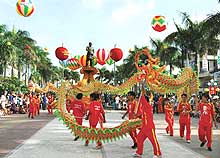 The
four-day festival, which draws on the still-fresh festive Tet (Lunar
New Year) atmosphere, is attracting revellers of all ages, mostly from
the large Hoa community in the city.
The
four-day festival, which draws on the still-fresh festive Tet (Lunar
New Year) atmosphere, is attracting revellers of all ages, mostly from
the large Hoa community in the city.
Beautiful lanterns hung up on a string remind beholders that Nguyen Tieu is also known as the “lantern festival.”
Eight lanterns believed to bring luck and prosperity will be awarded to winners cracking riddles.
In a small pool are fish fry for children to catch and take home for
prosperity. In the Chinese language, “fish” and “cash” are homonyms.
In the lobby are water-colour paintings by 38 Hoa painters like Truong Han Minh, Ly Khac Nhu, and Truong Van Y.
They are themed on spring celebrations, daily activities, and landscapes in which the buffalo is ubiquitous. In the Vietnamese zodiac, this is Ky Suu, or the Year of the Buffalo.
A stage, vivid with the colours and sounds typical of Chinese
culture, saw artists from different Hoa troupes dressed in ancient
costumes personifying legendary Chinese characters like Bat Tien (the
Eight Deities), Phuc, Loc, Tho (the Happiness, Prosperity, and Longevity
genies) conveying wishes to the crowd.
A curtain-raiser featuring dragon and kylin dances was followed by brilliant traditional dances and Chinese songs and theatre.
The show finished with gieo tu cau (tossing a love ball), an ancient
practice in which a single lady tossed a ball and wedded the man who
caught it. Of course, there was no groom-hunting and it was all in fun.
The event included a calligraph of the Chinese character for happiness written 100 times by Hoa artists.
It wraps up on February 9 with a procession in which 1,000 people
dressed as legendary characters or walking on stilts will take part.
Le hoi Nguyen Tieu originated in China in the second century BC when a
Han dynasty king ordered people to hang lanterns to celebrate his
coronation on the first full moon of the lunar year, according to
historians.